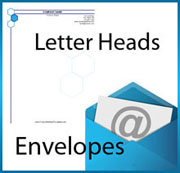
Letter Heads
Branding is a key to business success. Company logos and font design help to create brand when a business corresponds with partners, and current and potential customers. Individuals also create brand. You create brand when you write cover letters and send employers your resume and portfolio. Letterhead gives your correspondence a professional form which helps you to make a strong first impression.
Types
There are business and personal letterhead styles. Letterhead can be printed on various weights of paper and in small or standard size. Paper weights range from 9 to 200 lbs. Smaller letterhead paper is often used to create and send invitations.
Colored paper may help to add personality to your letterhead depending on the intent of your correspondence. Letterhead paper can be printed in more than 10 different colors and a multitude of different hues. For example, if you are using letterhead to send information about a 3-day company team building event you could print the letterhead on blue, yellow, red or green paper.
In addition to paper size, weight and color, you can also get letterhead in plain black and white ink, or printed in full color. The more colors you use, the more expensive the cost to have a printer design and print your letterhead. Also, there is a thought that black and white ink on a white or crème-colored paper presents the most professional business look.
Features
Letterhead print starts after 1 inch of blank space. Items included at the top of letterhead are: business name or your personal name, street address, city, state, zip, telephone, fax and email. The name and address lines of your letterhead can be printed at the far left, center or far right.
Considerations
Focus on the perception you want recipients of your correspondence to receive about you when you create your letterhead. Unless you create your letterhead yourself using a software package, a printer will likely print 500 or more copies of your letterhead in one job. Therefore, you will have the style, color, size and weight of the letterhead around for awhile. Focus, be creative, and make a good first impression.
Envelopes
An envelope is a common packaging item, usually made of flat material such as paper or cardboard. It is designed to contain a flat object, such as a letter or card.
Traditional envelopes are made from sheets of paper cut to one of three shapes: a rhombus, a short-arm cross, or a kite. These shapes allow for the creation of the envelope structure by folding the sheet sides around a central rectangular area. In this manner, a rectangle-faced enclosure is formed with an arrangement of four flaps on the reverse side.
|